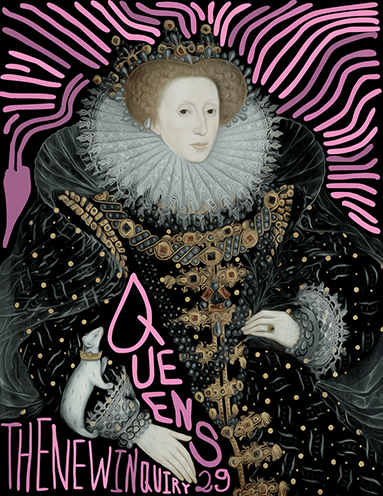This is the editorial note to The New Inquiry Magazine,
Vol. 29: Queens. Look inside the issue here.
Subscribe for $2 and get Queens (as well as free access to our archive of back issues) this week.
The queen addresses her audience. She is draped in ermine. She wears her jeweled crown and sits on her gold throne. It is the day she speaks to her assembled Parliament and delivers directives for the year. The representatives of capital stand before her, looking as obedient as children dragged to church. A single page boy faints, overcome by the power of the ceremony, but the queen does not signal that she notices. It seems like a grace note in the performance of her power, or a sad commentary on its actual application. Such is the plight of the queen.
A queen is the image of a woman at the height of her potential social standing. She evokes beauty, poise, and dignity simultaneously with power. Women who inhabit their social role fully and without struggle are crowned queens. But if the queen is the pinnacle, she is also the limit. If she is an exception to the general subordination of women, she proves the male rule.
We are now republicans, as far as the term goes. And the redistribution of royal titles can only be celebrated. Many more women than there have ever been noble families elicit cries of “queen” these days. “Queen,” unlike “princess,” functions as praise — though its deployment can teach us about the gender of power. She has avoided the fate of a princess, a title applied with more derision than awe, shaming women for articulating their desires as demands.
A queen is also ruthless, controlling, runs shit. A queen is not an executive, though. The corporate form of power is still far too fraternal to allow for anything so royal in the boardroom. A queen stands alone, fixed in place, with her subjects arrayed around her. This means she is also outnumbered. If her every movement seems deliberate, she might be self-possessed or she might be trapped.
In this issue, we explore the various valences of queendom. Beginning with an interview with Jarvis Derell, the voluble hashtagger behind #shehashadit, we discover the joys of “reading” and applaud the femme art of survival. By turning queens into #kweens, Derell opens up a social landscape where “the sorrows of long hours and urban poverty and precarious labor in the Sisyphean late-capitalist grind are reimagined as a series of joyful auditions and queer style choices and performative expressions of defiance.” And in “Seeing Stars,” Ana Finel Honigman assembles a collection of fan art devoted to female celebrity that rides on the dark energy of their public shame. Praise is central to the construction of the queen, though she must be strong enough to withstand the schadenfreude and sadism that inheres in celebration.
If queens live as exemplars of feminine performance, then most other types of women must be construed to miss her mark. In “Face Me, I Face You,” Derica Shields writes of searching visual culture for a reflection of herself and ends face-to-face with Queen Elizabeth I, her white head in the writer’s brown hand, both weighted with the unequal historical division of the spoils of slavery.
Not all queens are women — that’s clear — but not all drag is cis. In “You Don’t Own Me,” David Geer lauds drag sisterhood Chez Deep for their refusal to locate drag as the exposure of gender’s falsity, instead living drag as a form akin to goddess worship. While drag often does little but repackage the gender binary, Chez Deep prompts audiences to reject assumptions about the gendered subjectivity of the performer on stage. In return, Geer asks audiences to “rethink their relationship to drag performance and their responsibility as spectators.”
Early patriarchal attempts at codifying how to shut women up often left exemptions for funereal wails; later, all of women’s speech would be regarded as so much screaming. In “Scream Queens,” Kartik Nair investigates the sexual semiotics of the feminine shriek in horror films as they encounter early Hollywood censors and when they are dubbed into Hindi. The scream is part of a much larger body of emissions through which sexual difference is brought onto the screen, Nair writes. “What you hear is the sound of air passing through a matrix of sexual and social prescriptions.”
On other screens, queens project sexual difference as fate. In “Margot, Not at the Wedding,” Stephanie La Cava describes how she derived a stable of fetishes and a lesson in the feminized burden of survival from watching Patrice Chereau’s La Reine Margot at an impressionable age. The historic Margot has been immortalized in film numerous times, her story ripe with sham marriages, reversals of fortune, massacres, and betrayal. There may be two star-crossed lovers, but only one dies a martyr; Margot’s self-sacrifice ends in disgrace, poor queen.
We love queens because they are the supreme example of what we have. Their triumph as women can, from opportune angles, become women's triumph. But like on the chessboard, their dominating capability is still in the service of the rule of a king. We can't help but wonder what women might do or be after the queen's reign ends.
